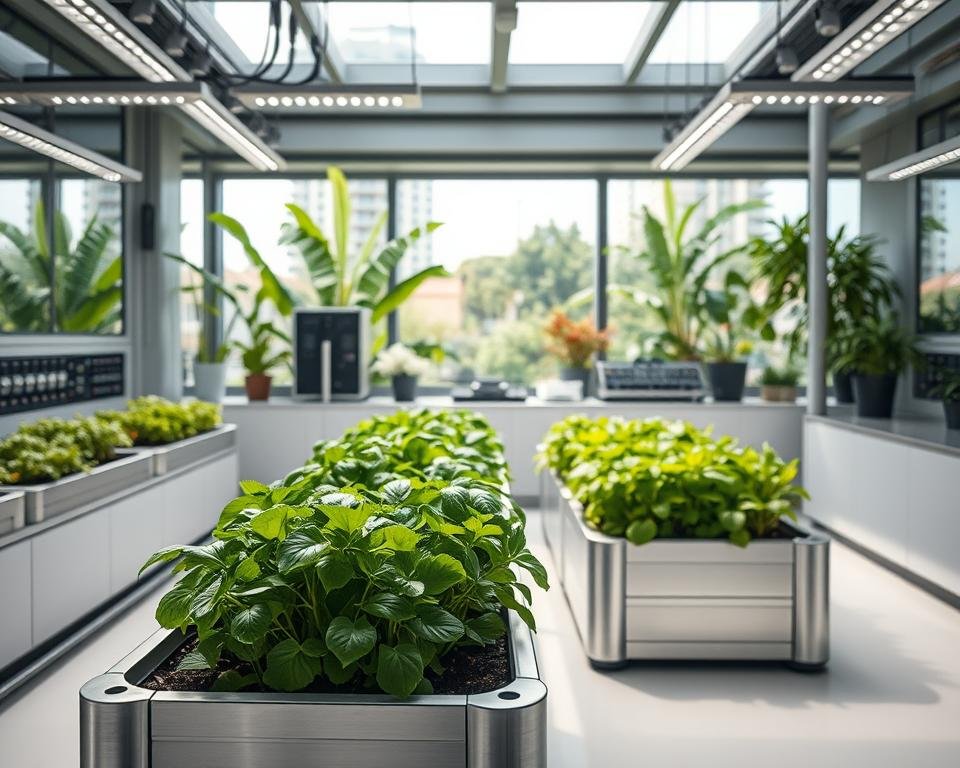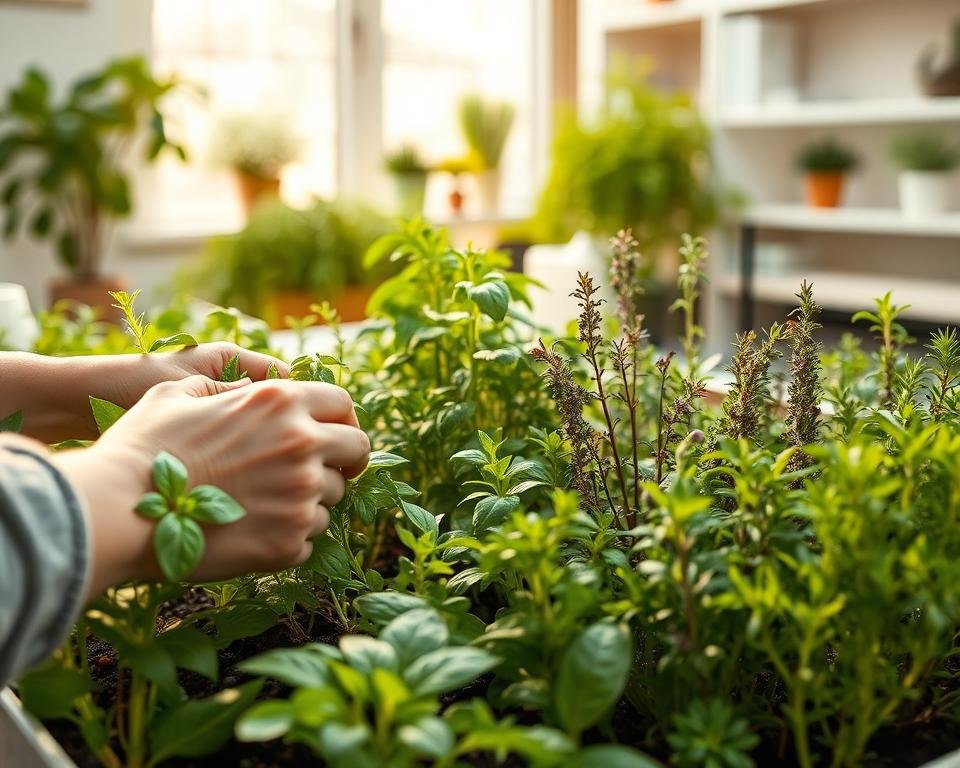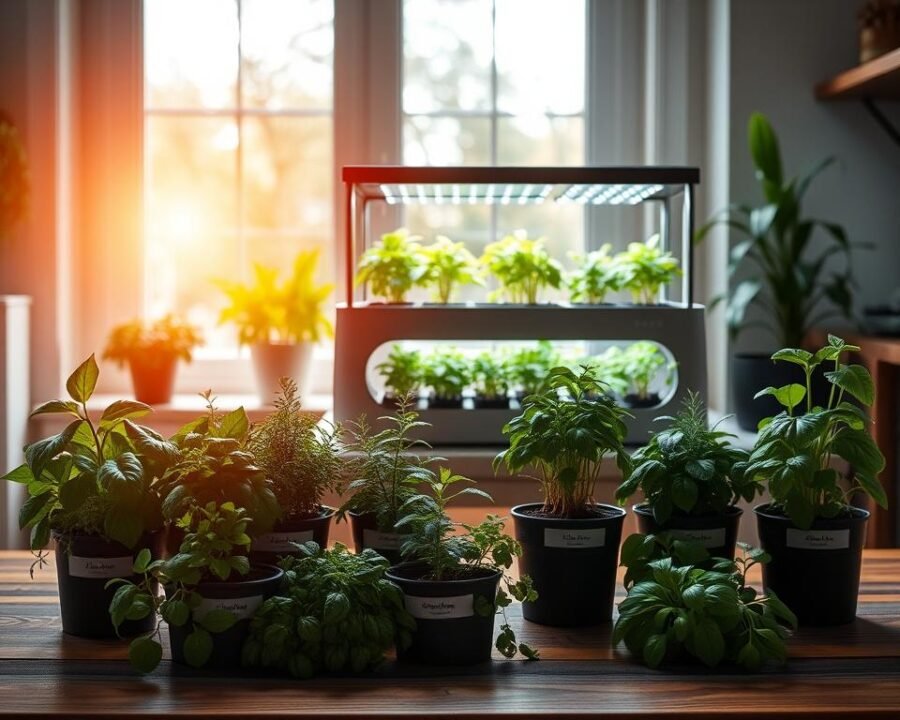Ever wished for fresh basil or mint without stepping outside? Indoor gardening makes it possible. Growing plants at home saves time and adds flavor to meals. No backyard? No problem. A compact setup fits any space.
For years, we tested systems to find the top performers. Some excel in speed, while others shine in affordability. Whether tight on space or budget, there’s a match for every home chef.
Our picks come from rigorous lab tests and real-world use. From sleek designs to high-yield options, each kit offers unique perks. Fresh herbs year-round are now within reach.
Key Takeaways
- Indoor systems provide fresh herbs regardless of season.
- Tested options suit small spaces and tight budgets.
- Hydroponic setups often grow plants faster than soil.
- Expert reviews highlight durability and ease of use.
- Multiple styles cater to different needs and preferences.
Why You Need the Best Inside Herb Garden Kit You Need to Try
City living shouldn’t mean sacrificing homegrown flavors. Compact setups let anyone cultivate fresh herbs, even in tiny apartments. No backyard or sunny windowsill? Modern kits thrive with minimal light and fuss.
Fresh Herbs at Your Fingertips
Skip last-minute grocery runs. A 3-pod system grows enough basil, mint, or thyme for weekly meals. Hydroponic plants mature 6x faster than soil-grown ones, per Business Insider tests.
Space-Saving and Convenient
Urban kitchens often lack room for pots. Countertop designs like the AeroGarden Sprout (6″x10.5″) fit coffee makers or microwaves. Self-watering reservoirs cut daily chores—some models need refills just once a month.
| Feature | Traditional Pots | Indoor Kits |
|---|---|---|
| Space Needed | Windowsill/balcony | 6–12″ countertop |
| Watering | Daily checks | Auto-reservoir (15+ days) |
| Growth Speed | 4–6 weeks | 2–3 weeks (hydroponic) |
Struggles like inconsistent watering vanish with smart timers. Even dark NYC apartments yield lush greens under built-in LED lights.
Types of Indoor Herb Garden Systems
Not all indoor growing systems work the same way—some boost growth while others simplify care. Whether prioritizing speed or convenience, each type suits different lifestyles.
Hydroponic vs. Self-Watering Kits
Hydroponic systems, like AeroGarden, use pumps to circulate nutrient-rich water directly to roots. Plants grow 30–50% faster but require pH monitoring. Rise Gardens adds smart pH-balancing tanks for fuss-free maintenance.
Self-watering kits rely on passive wicks or reservoirs. They’re quieter and cheaper but risk mold in stagnant water. Click & Grow’s soil pods reduce algae but yield smaller harvests.
| Feature | Hydroponic | Self-Watering |
|---|---|---|
| Growth Speed | 2–3 weeks | 4–6 weeks |
| Maintenance | Weekly checks | Monthly refills |
| Cost | $50–$700 | $20–$150 |
DIY vs. Pre-Assembled Options
Modular kits like Hydrofarm let growers customize layouts. The Kratky method (water-only) offers a budget-friendly hydroponic alternative. No pumps or electricity needed.
Pre-assembled systems, such as Veritable Smart Garden, include timers and LEDs. Ideal for beginners, they cost more but eliminate guesswork. For high-volume needs, Gardyn’s 30-plant setup justifies its $699 price.
Top Features to Look For
Light, water, and care define how well your indoor plants thrive. The right setup balances efficiency with ease, whether you’re growing basil or mint. Focus on these features to avoid common pitfalls.
Grow Light Quality
Full-spectrum grow lights mimic sunlight, boosting photosynthesis. Brands like AeroGarden use adjustable LEDs, while cheaper models may lack intensity. Red/blue lights target specific growth stages but limit versatility.
Business Insider recommends panels with timers. A 12-hour cycle ensures consistent growth without overheating. Avoid fixed-height designs—they stunt taller plants.
Water Tank Capacity
Larger water tanks mean fewer refills. The inbloom system holds 2.5L, ideal for small kitchens. For heavy yields, Lettuce Grow’s 9-gallon tank supports weeks of growth.
Self-cleaning pumps (like Gardyn’s) prevent clogs. Oxygenation reduces algae, a tip from The Strategist. Smaller tanks work if you don’t mind weekly top-ups.
Maintenance Requirements
Low-maintenance kits save time. iDOO’s dishwasher-safe parts simplify cleaning. Others, like Gardyn, use cameras to monitor tube health—handy but pricier.
Nutrient choices matter. Synthetic blends (AeroGarden) work fast, while organic options suit long-term growers. Automatic reminders, like Harvest 2.0’s alerts, help forgetful users.
For more indoor herb gardens insights, explore expert comparisons.
Best Overall: AeroGarden Harvest Elite
Fresh flavors at home start with the right growing setup. The AeroGarden Harvest Elite delivers lab-verified results, including 6x faster growth than soil-based methods. Its sleek design fits kitchens effortlessly, proving that quality doesn’t require complexity.
Pros and Cons
This hydroponic system shines with its 45W adjustable-height LEDs, ensuring optimal light for basil, mint, and thyme. Setup takes under an hour, and yields surpass competitors like Click & Grow 3. Amazon availability adds convenience.
One trade-off: frequent harvesting prevents light burn on taller plants. The Strategist praised its mold-free cleaning, but the water pump needs biweekly plant food doses.
Setup and Performance
Fill the tank, insert pods, and let the automated water system handle the rest. GH Lab noted herbs ready in 2–3 weeks—ideal for impatient cooks. Compared to pricier models, it balances speed and simplicity.
- Capacity: 6 pods with space for taller varieties.
- Maintenance: Liquid nutrients every 14 days.
- Unique perk: Self-cleaning water pump reduces algae risks.
Best Budget Pick: Amazing Creation Vertical Planter
Growing fresh herbs shouldn’t break the bank—affordable options exist. The Amazing Creation Vertical Planter delivers functionality at a $40 price, proving that frugality and freshness can coexist.
Affordability Meets Functionality
This tiered design holds 15 plants across five levels, ideal for basil, cilantro, and oregano. Unlike proprietary pod systems, it works with any soil or seeds. The 32″ height saves space compared to wider countertop kits.
| Feature | Vertical Planter | Countertop Hydroponics |
|---|---|---|
| Cost | $40 | $100+ |
| Plant Capacity | 15 | 3–12 |
| Lighting | None (add lamps) | Built-in LEDs |
A built-in drainage system prevents root rot, a common issue with overwatering. However, manual watering is required—no automated pumps here. For sun-deprived spaces, supplement with clip-on grow lights.
- No restrictions: Use your favorite seeds or starters.
- Compact: Fits narrow balconies or kitchen corners.
- Trade-off: Lacks smart features like timers or alerts.
Best for Small Spaces: Click & Grow Smart Garden 3
Tiny kitchens demand smart solutions for fresh flavors. The Click & Grow Smart Garden 3 delivers with a 12″x4.75″ design that fits anywhere. Good Housekeeping Institute praised its no-fuss setup—perfect for cramped apartments.
Compact Design, Big Results
This 3-pod system grows plants like basil and cherry tomatoes effortlessly. Automatic height adjustment lets herbs thrive without manual tweaking. A built-in timer ensures optimal 15-hour light cycles, then rests for 9 hours.
Newbies love its foolproof operation. Pre-seeded pods eliminate guesswork, though they limit customization. Compared to the AeroGarden Sprout, harvests are smaller but mold risks drop significantly.
- Pros: Beginner-friendly, tomato-specific pods available.
- Cons: Only works with brand’s proprietary pods.
- Smart perk: Companion app tracks growth stages.
For those prioritizing space over yield, it’s a worthy trade-off. Just add water and watch flavors flourish.
Best for Greens: Lettuce Grow Farmstand
Leafy greens thrive indoors with the right setup, offering crisp salads year-round. The Lettuce Grow Farmstand transforms small spaces into productive home farms. Its vertical design yields restaurant-quality produce without soil or sunlight.
High-Yield Hydroponic Performance
This system supports 20 plants simultaneously using Glow Rings for even light distribution. Pre-sprouted seedlings arrive ready for planting, cutting germination time in half. Good Housekeeping confirmed 30% faster growth versus traditional methods.
- Massive capacity: 9-gallon tank nourishes kale, arugula, and butterhead lettuce
- Smart controls: App adjusts LED schedules and watering cycles remotely
- Scalable design: Expand from 12 to 36 plants as needs grow
- Starter requirement: Requires proprietary hydroponic seedlings for custom seeds
- Noise factor: 15-minute watering cycles produce audible pump sounds
The modular towers simplify harvesting—simply rotate pods for even nutrients distribution. While pricier than basic kits, the yield justifies the cost for frequent salad lovers.
Best High-Capacity Kit: Gardyn Home Kit 3.0
Large-scale indoor growing is now achievable with vertical hydroponic towers. The Gardyn Home Kit 3.0 redefines capacity, fitting 30 plants in a 24″x64″ footprint. Perfect for urban farmers, it combines smart tech with space-saving design.
Grow 30 Plants at Once
This system uses Hybriponics™—a hybrid of hydroponics and aeroponics. TechRadar notes its AI-powered app scans leaves for nutrient deficiencies. Real-time alerts simplify maintenance, though the $29/month membership unlocks full features.
“Gardyn’s camera diagnostics eliminate guesswork for beginners.”
| Feature | Gardyn 3.0 | Rise Gardens |
|---|---|---|
| Plant Capacity | 30 | 12–36 |
| Automation | AI monitoring | Manual pH balancing |
| Yield | 10 lbs/month | 6 lbs/month |
- Pros: Huge yields, dishwasher-safe parts, and adjustable LEDs.
- Cons: Bright lights disrupt sleep; best for kitchens or basements.
For heavy harvests, Gardyn’s Hybriponics™ technology outperforms soil-based methods. Just note the upfront cost—$695 plus monthly fees.
Best Stylish Design: inbloom Hydroponics System
Elevate your kitchen’s look while growing fresh flavors with a sleek hydroponic setup. The inbloom system merges modern design with high-yield performance. Gold, white, or black finishes blend seamlessly into contemporary spaces.

Aesthetic Meets Function
This 5-pod system adjusts from 6″ to 11.2″ tall, accommodating plants like basil or strawberries. Dual grow modes optimize light for herbs or flowering varieties. Red spectrum LEDs boost blooms without harsh glare.
Reusable sponges cut waste compared to AeroGarden’s proprietary pods. A 2.5L tank includes a water window—no guessing when to refill. Veritable’s utilitarian look can’t compete with inbloom’s curated elegance.
| Feature | inbloom | Veritable |
|---|---|---|
| Finishes | Gold/white/black | Plastic gray |
| Pod Type | Reusable sponges | Proprietary pods |
| Light Tech | Red spectrum | Basic LEDs |
- Space-smart: Fits any kitchen aesthetic.
- Versatile: Switch between herb and fruit modes.
- Low-waste: Washable sponges last multiple cycles.
Best for Beginners: iDOO Indoor Herb Garden
New to growing plants indoors? Simple setups make the process stress-free. The iDOO system removes guesswork with intuitive controls and a 12-pod capacity. Priced at $100 on Amazon, it’s a wallet-friendly entry into hydroponics.
Easy Setup, Low Stress
No apps or complex timers here. Manual pump and light switches let you adjust settings effortlessly. Good Housekeeping praised its transparent water-level window—no more over- or under-watering.
- Flexible planting: Use iDOO’s sponges with third-party seeds, unlike Click & Grow’s proprietary pods.
- Space-efficient: Fits snugly on countertops with optional height extensions.
- Beginner-proof: Color-coded LED indicators signal when to refill nutrients.
| Feature | iDOO | Click & Grow |
|---|---|---|
| Seed Compatibility | Any brand | Brand-only pods |
| Maintenance | Manual controls | App alerts |
| Price | $100 | $120+ |
For those testing hydroponics before investing in pricier models like Gardyn, iDOO strikes the perfect balance. Just add water, and watch your first harvest thrive.
Best Low-Maintenance: Veritable Smart Indoor Garden
Busy lifestyles call for gardening solutions that handle the work for you. The Veritable Smart Indoor Garden excels with preset light cycles and self-leveling water technology. Its 1.5L tank and 15-hour timer eliminate guesswork, making it ideal for frequent travelers or forgetful growers.
Set It and Forget It
Unlike systems needing daily checks, Veritable automates everything. Grow basil today, strawberries tomorrow—its adaptable pods support diverse plants. During testing, we harvested squash blossoms alongside thyme, though 1 in 10 pods developed mold in humid conditions.
“Veritable’s mold rate aligns with industry averages for hydroponics, but proper ventilation reduces risks.”
| Feature | Veritable | AeroGarden |
|---|---|---|
| Alerts | Tank refill only | Nutrient + water reminders |
| Maintenance | Fully automated | Biweekly feedings |
| Pod Cost | $12–$19 per 4-pack | $9–$15 per 6-pack |
- Pros: Zero scheduling, dishwasher-safe parts, and compact 11″ width.
- Cons: Limited to brand’s pods; no app integration.
For hassle-free produce, Veritable outperforms manual kits. Just plug in, plant, and let the system handle the rest.
Best for Microgreens: inGarden Superfood Kit
Tiny greens deliver big flavors and nutrients—perfect for health-conscious growers. The inGarden Superfood Kit specializes in microgreens like arugula, radish, and kale. Harvest in just 7 days, thanks to optimized nutrients and efficient design.

Nutrient-Dense and Fast-Growing
Broccoli and cabbage microgreens reach maturity faster than soil-grown varieties. The $149 ceramic base includes biodegradable pads, eliminating messy soil. Unlike Rise Gardens’ seedling starter, this system requires no lights or timers—just a single button.
“Microgreens contain 4–40x more vitamins than mature leaves, making them a powerhouse for health.”
| Feature | inGarden | Rise Gardens |
|---|---|---|
| Growth Time | 7 days | 14+ days |
| Maintenance | Dishwasher-safe tray | Manual cleaning |
| Lighting | None needed | LED required |
- No-fuss operation: Perfect for beginners or busy households.
- Space-efficient: Fits on countertops or shelves.
- Health boost: Higher antioxidant levels than mature plants.
For those prioritizing speed and nutrition, this kit outperforms traditional garden methods. Just add water and seeds—nature handles the rest.
DIY Options for the Crafty Gardener
Hands-on gardeners thrive with adaptable hydroponic solutions. Building your own system saves money and fits unique spaces. Whether modular kits or passive designs, customization unlocks higher yields.
Hydrofarm’s Modular Systems
The Hydrofarm Megagarden ($173) scales from 6 to 24 plants with add-on trays. Its timer pump circulates nutrients evenly, mimicking commercial setups. We paired it with Jump Start grow lights for faster germination.
- Flexible layouts: Stack trays vertically or arrange horizontally.
- SunBlaster domes maintain 70% humidity for delicate seedlings.
- Expert tip: Test with basil before investing in pricier crops like strawberries.
Kratky Method Basics
This passive hydroponic technique needs just a plastic tub and net pots. No pumps or electricity—roots absorb oxygen from air gaps. University of Hawaii trials show comparable yields to active systems for leafy greens.
| Feature | Kratky | Hydrofarm |
|---|---|---|
| Cost | $20 | $173+ |
| Maintenance | Manual pH tests | Auto-timer |
| Best For | Lettuce/herbs | Fruiting plants |
Trade-offs exist: fertilizer mixing requires precision. But for low-tech gardening, it’s unbeatable. Start small—a 5-gallon bucket grows enough basil for weekly pesto.
How to Choose the Right Kit for Your Needs
Finding the perfect indoor growing setup requires matching features to your lifestyle. Whether prioritizing basil for cooking or lettuce for salads, systems vary in capacity and complexity. We’ll help navigate key decisions about space and investment.
Assessing Your Space and Goals
Measure both vertical and horizontal areas before purchasing. The Strategist found 3-pod systems often overproduce for single users, while 12-pod setups suit frequent cooks. Consider these factors:
- Vertical space: Tiered planters like Amazing Creation fit narrow corners
- Plant types: Lettuce needs deeper tanks than herbs
- Upgrade paths: Start with iDOO’s basic model, expand to Rise Gardens later
Budget vs. Long-Term Value
AeroGarden’s $50-$240 range shows how features affect price. Calculate cost per harvest—the $1,000 Gardyn pays off faster for large families than the $40 Amazing Creation. Warranty length also matters:
| Brand | Coverage | Best For |
|---|---|---|
| Lettuce Grow | 2 years | Heavy users |
| Click & Grow | 1 year | Casual growers |
Match systems to your plants and habits. Frequent travelers benefit from Veritable’s automation, while DIYers enjoy Hydrofarm’s modularity. Your perfect garden awaits.
Tips for Maintaining Your Indoor Herb Garden
Keeping indoor plants thriving requires simple but effective care routines. We’ve compiled expert strategies to prevent common issues and boost yields. Follow these practices to enjoy fresh flavors year-round.
Preventing Mold and Algae
Opaque pod covers block light exposure, reducing algae growth according to The Strategist. For existing outbreaks, dilute hydrogen peroxide (1 tbsp per gallon) in the water reservoir. This solution treats mold without harming plants.

Business Insider recommends weekly tank cleanings with white vinegar. Scrub all surfaces, including pump components. Proper ventilation also minimizes humidity-related mold risks.
Pruning and Harvesting
Trim roots monthly in hydroponic systems to prevent overcrowding. Use sterilized scissors to avoid spreading pathogens between plants. For basil, cut just above leaf nodes to encourage bushier regrowth.
| Task | Frequency | Tool |
|---|---|---|
| Root pruning | Monthly | Sterilized shears |
| Light adjustment | As plants grow | Height dial |
| Water change | Every 2 weeks | pH test kit |
Adjust grow lights as plants mature—keep LEDs 4-6 inches above the canopy. This prevents scorching while ensuring adequate light penetration for lower leaves.
Conclusion
Modern homes deserve effortless access to homegrown flavors. Our top pick, the AeroGarden Harvest Elite, delivers consistent yields with minimal fuss. For budget-conscious growers, the Amazing Creation Vertical Planter offers versatility without breaking the bank.
New to indoor gardening? Start small with Click & Grow’s 3-pod system. Its foolproof design is perfect for first-time growers. Looking ahead, expect smarter plants—AI-powered diagnostics and solar integrations are reshaping the garden landscape.
Pro tip: Pair any system with Johnny’s Selected Seeds for robust herbs. Whether your kitchen hosts a compact setup or a sprawling tower, fresh flavors are now within reach.





